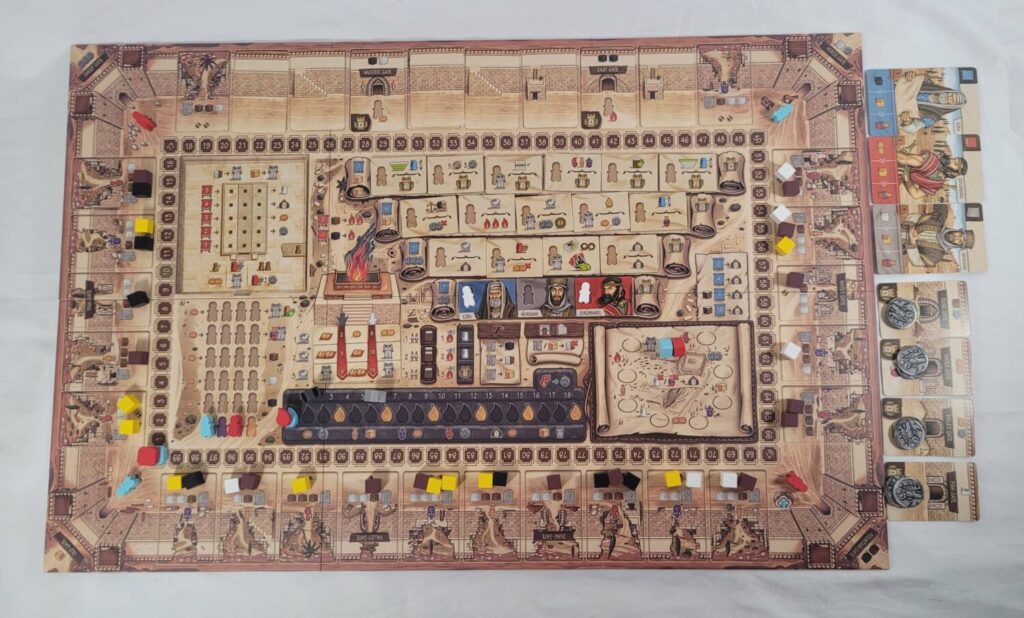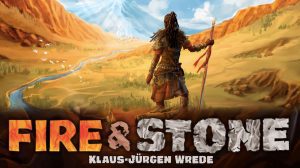Disclosure: Meeple Mountain received a free copy of this product in exchange for an honest, unbiased review. This review is not intended to be an endorsement.
From Wikipedia: “In the early 6th century Judah rebelled against Babylon and was destroyed (586 BCE). The royal court and the priests, prophets and scribes were taken into captivity in Babylon. There the exiles blamed their fate on disobedience to God and looked forward to a future when a penitent and purified people would be allowed to return to Jerusalem and rebuild the Temple.”
Decades later, this future they looked forward to came to pass.
The game Ezra and Nehemiah chronicles the challenges that the noted priest and scribe, Ezra, and cup-bearer to king Artaxerxes of Persia, Nehemiah, faced as they worked to restore the city of Jerusalem to its former glory and bring the word of the gospel to the people therein. In the game, players will be using their hand of cards and the workers at their disposal to clear away the rubble of the destroyed city, rebuild the walls and the temple, and teach the Torah to the people.
It is worth noting here that, while Ezra and Nehemiah is inspired by biblical events and takes place in the setting of the story, it is not a religious game. It is a meaty, thinky eurogame with a lot of moving parts and interconnected systems. The aim of the game is to earn the most points by game’s end and there are myriad ways of scoring them.
Each round, players will play a card from their hand into their tableau and, using the banners on that card and the cards played before it, perform their chosen action. The effectiveness of each action is boosted by the number of banners matching that action’s type that the player has available to them. These actions allow the players to do things such as clear away rubble, collecting those removed resources for future use as well as creating room to build walls; send Levites to the temple to make offerings and keep the fires of the altars burning (two of the primary ways to score points); and to use scholars to study and teach the Torah, gaining access to powerful game-breaking abilities and valuable resources along the way.
Of course, this is a high-level overview of the game. Read on to get a better idea of how the game is played. Or, if you prefer, you can jump straight to the Thoughts section to see what I think.
The Return of the Exiles
Ezra and Nehemiah is played around a Main board that is divided into several distinct sections, and each player’s Player board. In the center of the Main board, starting at the top left and going clockwise, are the Temple, the Altar, the Torah teaching area, the Tents, the Altar track (with informational tidbits/reminders above it, and the Levites. This area is surrounded by the Score track, and this is further surrounded by the wall and gate spaces. Depending on player count, a number of the Wall and Gate spaces will be seeded with resource cubes. Some may have even been covered up entirely.

Each player’s Player board features several notches that are designed to hold several randomized Development tiles—Guards, Laborers, Farmers, Traders, and Elders. The Player boards also feature a Blessing track as well as three areas at the bottom where players will be placing their cards.
As the game begins, players will have chosen a color and collected several starting resources, several workers, and they will have placed their player pieces out onto their Player board and the Main board in their appropriate starting positions. Players also receive a deck of shuffled Character and Wall cards in their color.

Once everyone has received their stuff and everything is set up, a starting player is chosen, given the Shofar (first player token), and the game can begin.
Jerusalem’s People
Ezra and Nehemiah is played over the course of three rounds (a.k.a – weeks), each of which are divided into seven days (a.k.a. – turns). During the first six days, players will be selecting one of the Character cards from their hand to play onto their Player board, performing their actions after the selected card has been played. On the fourth through sixth turns, the players will have to place their cards on top of already played cards with no more than two cards in each stack. On the seventh day, the Sabbath will occur. More on this later.

Each Character card is unique, but they all have the same layout. At the top left of the card are several banners in various (or the same) colors. Across the top of the card is an ability the players may gain access to if they decide to tuck the card when the time comes to do so. Beneath this is an image of the person the card represents, along with a word or two describing who they are. Beneath this is the character’s trade action.
Rising From the Rubble
Each of the three banner colors—red, blue, grey—interact with specific parts of the city. After a player has played their card for the turn, they’ll choose a color, count up all the banners of that color that they have access to, and then perform the actions associated with their chosen color.
Red allows the players to add workers to the Levite track and/or interact with the Temple and the Altar locations. Each Levite placed provides instantaneous benefits. Furthermore, the number of Levites a player has will directly affect how beneficial the Temple and Altar actions are. Generally speaking, the more Levites a player has, the more offerings they will be able to send to the Temple and/or Altar. Levites can also be used to act as additional red banners for the turn.
Sending offerings to the Temple will gain the player immediate rewards as well as in-game victory points. Sending offerings to the Altar will allow the player to progress along the Altar track. Movement along the Altar track will result in some instant benefits, but also acts as a tiebreaker. There are also end-of-round checks to determine how well each player is progressing along this track. Depending on how well they are doing, they may gain, or even lose, resources, points, or food.
Blue allows the player to send scribes to teach the Torah, as well as move their tents around the city. The Torah section of the main board is divided into four rows of scrolls. Placing workers onto these scrolls to gain access to their abilities will cost the players some combination of blue banners, plus coins or resources. The higher the row, the higher the cost. The lower rows of scrolls give players access to powerful, in-game abilities. For instance, there is one scroll that, once claimed, allows the player that has claimed it to ignore the need to feed their workers during the Sabbath. The highest tier of scrolls rewards the players with bonus points during end of game scoring for meeting specific criteria.
Beneath the scroll area is the tent area, a small representation of the city proper surrounded by a cyclical track where the players’ Tent pawns sit. As players move their tents from one space into the next, they will receive a small bonus in the form of resources, money, workers, movement along the Altar track, victory points, or movement along one of the Blessing tracks on their Player boards. Thematically, this represents the players going out into the surrounding populace and spreading the teachings of the Torah.
Grey allows the players to remove rubble from the building spaces (resources they will be using later on) and then build walls and gates on those spaces. Building these gains the player useful resource bonuses and also serves as a major source of end-game victory points.
Auxiliary Actions
Additionally, players may either trade with the Character card they’ve just played to their tableau or flip over one of their Development tiles to gain access to its upgraded benefits and end-of-game victory points. Players also have the option of using either 1 Trader and/or 1 Elder Development tile.
Each Character card depicts two types of trades, allowing you to give up something in order to gain something else. Some may force you to choose between the two, while others allow you to go hog wild, trading as much as you want without any restrictions. Some are associated with specific gates and a player must pay the owner of the specified gate a coin before they can use the trade action.
Flipping a Development tile will gain a player access to the Development tile’s more powerful set of actions and may even gain that player some kind of instant bonus. There is a cost associated with flipping any given tile that must be paid before the tile can be flipped. Flipping these tiles is another source of end game victory points.
To use a Trader, a player devotes one of their available workers to an open trade spot and they receive whichever resources that trader provides. Elders work much the same as Traders, except they provide access to additional banner icons for a player during the turn in which their worker is assigned to that spot.
On the Seventh Day
On the seventh turn of a round, a Sabbath will occur. During the Sabbath’s “Prepare for Sabbath” step, players will assign any leftover workers to work as farmers and/or laborers where they will produce some mixture of resources and/or food. They may also carry out any “Prepare for Sabbath” steps they may have unlocked in any order they choose.
Then the Prophet’s Judgment is carried out. During such a Judgment, the players’ positions on the Altar track are compared with the positions of the Prophet pawns that were placed above the track during setup. They will then receive some reward or penalty based on how well they compare. The Prophets then move to their positions for the next week.
Then, players must feed their workers or lose victory points for those they cannot feed. After feeding (or not), each player chooses a Character card from the six that were played to tuck. That card is unavailable to them for the remainder of the game. However, players will now have permanent access to a flag icon as well as that Character’s special end-of-round scoring condition. These tucked cards are scored at the end of every round—useful guideposts in a game with so many options to choose from.
At the end of the game, points are tallied to determine a winner. In addition to points scored during the game, end-of-game points come from a variety of sources: leftover money, flipped Development tiles, being the leader on the Altar track, constructed Walls and Gates, the location of your Scribes in the Torah section of the Main board, and the top row of Scroll tiles.
Thoughts
Ezra and Nehemiah really speaks to me. It’s got all of the things that I like in a game: mechanics that mesh well with the theme, fantastic artwork and table presence, and it’s bursting at the seams with meaty, thinky, puzzly gameplay. It’s a game that rewards careful planning as much as it rewards the ability to adapt quickly when things aren’t going according to plan.
As an example of the kinds of decisions you’ll be faced with, consider the following:
Workers provide you with more flexibility. The more you have, the more you can do. But, they come with a downside: unless you turn them into Levites, you’ve got to keep them fed or they’ll cause you to start hemorrhaging points. At first, it seems like a no-brainer to just turn your workers into Levites. But, as you start moving further up the Levite track, the food costs to convert workers into Levites begin to skyrocket. Suddenly, it becomes cost prohibitive to do so. You’re literally taking food out of the mouths of your other workers. So, what do you do? Do you focus on building up a solid food engine? Is it even worth it to do so? After all, if the only thing your workers are doing is producing food just to keep them fed, are they actually improving your position?
You’ll also find yourself agonizing over things such as how to optimize your actions so that none of their benefits are wasted (figuring out how to remove rubble and build at the same time, for example) and which card to place down on your turn and in which slot to place it (remember: you’re not only choosing which banners are available, but you’re also choosing a possible end-of-round scoring opportunity as well). And there’s also the matter of timing. Timing can be very important.
In the last game I played, looking over the game state right after setting up, I noticed a scroll tile that would reward me with some silver and a free auxiliary action in the “Prepare for Sabbath” step. Looking at my initial hand of cards, I noticed that one of the characters I was holding, when tucked, would reward me points based on how many Development tiles I had managed to flip over. I also noticed that one of my Development tiles would provide me with two resources for each worker placed on it during the same step. I also knew that tucked Characters score during the actual Sabbath step, and only after you’ve tucked a card from your hand.
So, during my first week, I played that Character card from my hand, went straight for that scroll tile, and even managed to flip one of my Development tiles before the week came to an end. During the ‘Prepare for Sabbath’ step, I assigned two workers as laborers to gain 4 stone, and then used the auxiliary action from the scroll tile to flip over a second Development tile, which I paid for using the stone I’d just collected. Then, during the Sabbath, I tucked the Character card that rewarded me for flipped Development tiles and scored 4 points. By the next Sabbath, I had two more flipped Development tiles, which scored me 8 points. And, during the final Sabbath, I had all of my Development tiles flipped, which scored me another 10, a combined total of 22 points. None of that would have been possible without an understanding of the game’s timing.

As you can see, there’s a lot to think about here. Ezra and Nehemiah asks a lot of you. There’s a lot of reading and a lot of math involved. There’s even a decent amount of having to make the best of bum luck. At times, it can start to feel a little overwhelming, and this may not sit well with some people.
Another tick in the cons column is an issue I’ve groused about in other reviews. There are a lot of tiles and cards in this game, and there’s a hefty amount of iconography. Figuring out what a specific scroll tile does or what a particular Character’s scoring criteria are can be tricky without some sort of reference. Thankfully, Ezra and Nehemiah provides an appendix which describes all of the aspects in great detail. Unfortunately, it’s buried in the back of the rule book—and everybody’s wanting to look at it. That’s not so bad in a two-player game, but when you’ve got four people clamoring for the same reference material, it can become tedious. And, to make things even worse, the tiles aren’t numbered, making it hard to find what you’re looking for quickly.
I really wish the Appendix was a document separate from the rulebook, and I really wish there were multiple copies of it provided.
Aside from that gripe, I have nothing but praise for this excellent game. Shem Phillips and Sam MacDonald have proven, once again, that they are a force to be reckoned with.












Add Comment